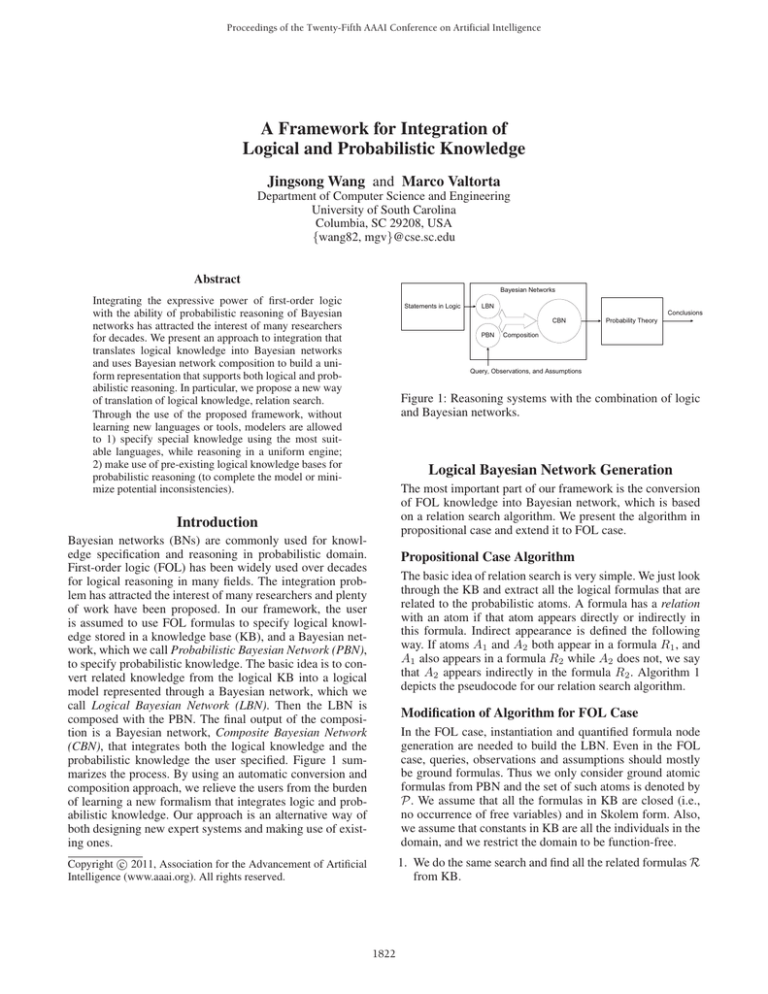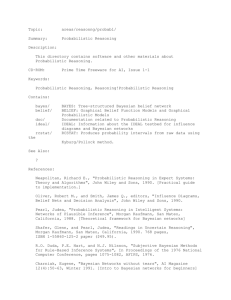
Proceedings of the Twenty-Fifth AAAI Conference on Artificial Intelligence
A Framework for Integration of
Logical and Probabilistic Knowledge
Jingsong Wang and Marco Valtorta
Department of Computer Science and Engineering
University of South Carolina
Columbia, SC 29208, USA
{wang82, mgv}@cse.sc.edu
Abstract
Bayesian Networks
Integrating the expressive power of first-order logic
with the ability of probabilistic reasoning of Bayesian
networks has attracted the interest of many researchers
for decades. We present an approach to integration that
translates logical knowledge into Bayesian networks
and uses Bayesian network composition to build a uniform representation that supports both logical and probabilistic reasoning. In particular, we propose a new way
of translation of logical knowledge, relation search.
Through the use of the proposed framework, without
learning new languages or tools, modelers are allowed
to 1) specify special knowledge using the most suitable languages, while reasoning in a uniform engine;
2) make use of pre-existing logical knowledge bases for
probabilistic reasoning (to complete the model or minimize potential inconsistencies).
Statements in Logic
LBN
Conclusions
CBN
PBN
Probability Theory
Composition
Query, Observations, and Assumptions
Figure 1: Reasoning systems with the combination of logic
and Bayesian networks.
Logical Bayesian Network Generation
The most important part of our framework is the conversion
of FOL knowledge into Bayesian network, which is based
on a relation search algorithm. We present the algorithm in
propositional case and extend it to FOL case.
Introduction
Bayesian networks (BNs) are commonly used for knowledge specification and reasoning in probabilistic domain.
First-order logic (FOL) has been widely used over decades
for logical reasoning in many fields. The integration problem has attracted the interest of many researchers and plenty
of work have been proposed. In our framework, the user
is assumed to use FOL formulas to specify logical knowledge stored in a knowledge base (KB), and a Bayesian network, which we call Probabilistic Bayesian Network (PBN),
to specify probabilistic knowledge. The basic idea is to convert related knowledge from the logical KB into a logical
model represented through a Bayesian network, which we
call Logical Bayesian Network (LBN). Then the LBN is
composed with the PBN. The final output of the composition is a Bayesian network, Composite Bayesian Network
(CBN), that integrates both the logical knowledge and the
probabilistic knowledge the user specified. Figure 1 summarizes the process. By using an automatic conversion and
composition approach, we relieve the users from the burden
of learning a new formalism that integrates logic and probabilistic knowledge. Our approach is an alternative way of
both designing new expert systems and making use of existing ones.
Propositional Case Algorithm
The basic idea of relation search is very simple. We just look
through the KB and extract all the logical formulas that are
related to the probabilistic atoms. A formula has a relation
with an atom if that atom appears directly or indirectly in
this formula. Indirect appearance is defined the following
way. If atoms A1 and A2 both appear in a formula R1 , and
A1 also appears in a formula R2 while A2 does not, we say
that A2 appears indirectly in the formula R2 . Algorithm 1
depicts the pseudocode for our relation search algorithm.
Modification of Algorithm for FOL Case
In the FOL case, instantiation and quantified formula node
generation are needed to build the LBN. Even in the FOL
case, queries, observations and assumptions should mostly
be ground formulas. Thus we only consider ground atomic
formulas from PBN and the set of such atoms is denoted by
P. We assume that all the formulas in KB are closed (i.e.,
no occurrence of free variables) and in Skolem form. Also,
we assume that constants in KB are all the individuals in the
domain, and we restrict the domain to be function-free.
1. We do the same search and find all the related formulas R
from KB.
c 2011, Association for the Advancement of Artificial
Copyright Intelligence (www.aaai.org). All rights reserved.
1822
Algorithm 1 Relation Search
The proof uses weighted model counting (Darwiche
2009), over G, to prove the joint probability of evidence
Pr(e) = 0, where e = {U = f alse} ∪ V = true, and
then follow Bayes’ rule to conclude the posterior probability Pr(U = true|V = true) = 1.
Require: the probabilistic atom set P from PBN containing query,
observations, and assumptions, the set of logical formulas KB
= {R1 , R2 , ..., Rz }, z = |KB|, and the sets A1 , A2 , ..., Az .
Ai comprises all the atoms appearing in its corresponding logical formula Ri ∈ KB, where 1 ≤ i ≤ z.
1: V = P;
2: E = ∅;
3: L = ∅;
4: for i = 1 to z do
5:
Tag Ri as not visited;
6: end for
7: while true do
8:
Changed ⇐ false;
9:
for i = 1 to z do
10:
if Ri is not visited then
11:
if Ai ∩ V = ∅ then
12:
V = V ∪ Ai ∪ {Ri };
13:
for all A ∈ Ai do
14:
E = E ∪ {(A, Ri )};
15:
end for
16:
Build CPT Θi for Ri based on its logical structure;
17:
L = L ∪ {Θi };
18:
Tag Ri as visited;
19:
Changed ⇐ true;
20:
end if
21:
end if
22:
end for
23:
if Changed = false then
24:
break;
25:
end if
26: end while
27: return BN (V, E, L);
Composition
The composition process of Bayesian networks (LBN and
PBN) is supported by ontology (Huhns, Valtorta, and Wang
2010). Definitions of terms from an ontology is essential for
combining the logical knowledge with the probabilistic one
in our framework, as different definitions (of equality or inclusion) may result in different LBNs. Ontology also makes
composition process much more flexible and adaptable, for
example, the use of subclass relationship for more specific
information analysis.
Conclusion
Most techniques for handling integration problem are designed completely as a new formalism such as BLOG (Milch
et al. 2005) or an extension of either FOL such as
MLN (Richardson and Domingos 2006) and SLP (Muggleton 1996) or Bayesian networks such as MEBN (Laskey
2008) and BLP (Kersting and De Raedt 2001). Users have
to study new ways of modeling, a process that is hard and
always comes with waste of effort as many techniques are
still in the preliminary stage for practical use. We did not
propose a new language, but a framework that can automatically and efficiently transform the users’ knowledge expressed in these two traditional formalisms into one representation for probabilistic reasoning. We expect this framework to be easy to understand, simple to implement, and
efficient to execute. Evaluation of this claim is a major topic
of our ongoing work. Details and other related work including comparisons can be found at http://www.cse.sc.
edu/˜wang82/doc/aaai2011.
2. We use available constants in R ∪ P to get all the possible
ground instantiations of quantified formulas in R, and add
these instantiations to R. This new set is named R .
3. We build a Bayesian network based on R . We follow exactly the same procedure as in the propositional case for
generating nodes, edges, and CPTs for the ground formulas in R . For a quantified formula, we put it as the child of
its ground instantiations (groundings) plus an extra node
O, which represents a proposition that all the other instantiations that are based on constants appearing in KB but
not in R hold. The CPT For such a quantified formula is
an AND table, i.e., the value true has probability 1 if all
parents are true and probability 0 otherwise.
References
Darwiche, A. 2009. Modeling and Reasoning with Bayesian
Networks. Cambridge University Press.
Huhns, M.; Valtorta, M.; and Wang, J. 2010. Design principles for ontological support of Bayesian evidence management. In Obrst, L.; Janssen, T.; and Ceusters, W., eds., Semantic Technologies, Ontologies, and Information Sharing
for Intelligence Analysis. Amsterdam: IOS Press. 163–178.
Kersting, K., and De Raedt, L. 2001. Bayesian logic programs. CoRR cs.AI/0111058.
Laskey, K. B. 2008. MEBN: A language for first-order
knowledge bases. Artificial Intelligence 172:140–178.
Milch, B.; Marthi, B.; Russell, S.; Sontag, D.; Ong, D. L.;
and Kolobov, A. 2005. BLOG: Probabilistic models with
unknown objects. In In IJCAI, 1352–1359.
Muggleton, S. 1996. Stochastic logic programs. In
De Raedt, L., ed., Advances in Inductive Logic Programming. IOS Press. 254–264.
Richardson, M., and Domingos, P. 2006. Markov logic networks. Machine Learning 62(1-2):107–136.
Therefore for the FOL case, the generated Bayesian network will usually be a three level network if quantified formulas exist in R . The nodes corresponding to them are in
the third level. One important change for the FOL case relation search output is an O node for each quantified formula
as one additional parent.
Proof of Correctness
Theorem 1 For a BN resulting from relation search, G =
(V, E, L), for any U ∈ V and any V ⊆ V, if V |= U , then
Pr(U = true|V = true) = 1 in G, where V = true means
that all the nodes in V of G are set to true.
1823





